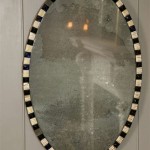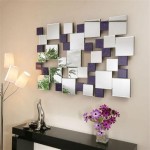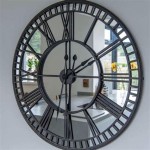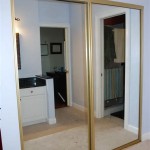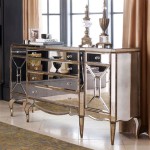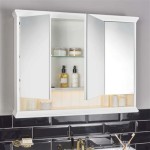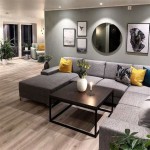Wall Mirrors in the Living Room: Enhancing Space and Style
Wall mirrors have long been a staple in interior design, serving both functional and aesthetic purposes. In the living room, a strategically placed mirror can dramatically transform the space, impacting perceptions of size, light, and overall ambiance. This article explores the various benefits and considerations involved in incorporating wall mirrors into living room design.
One of the most significant advantages of using wall mirrors in the living room is their ability to create an illusion of spaciousness. In smaller rooms or those with limited natural light, a well-positioned mirror can effectively double the perceived space. By reflecting the room's contents, including furniture and light sources, a mirror creates a sense of depth and openness, making the area feel larger and less confined.
Amplifying natural light is another key benefit of incorporating mirrors into living room design. A mirror placed opposite a window can reflect incoming sunlight deeper into the room, brightening even the darkest corners. This can reduce the need for artificial lighting during the day, saving energy and creating a more welcoming atmosphere. The strategic placement of mirrors can also help balance the light distribution in a room, particularly in spaces with uneven natural light sources.
Beyond functionality, wall mirrors contribute significantly to the overall aesthetic of a living room. They can serve as striking focal points, adding a touch of elegance and sophistication. Depending on the frame style and size, a mirror can complement various design schemes, from classic to contemporary. Large, ornately framed mirrors can create a grand, traditional feel, while minimalist frameless mirrors can enhance a modern, sleek aesthetic.
The shape and size of a wall mirror play a crucial role in its impact on the living room. Large rectangular mirrors can create a sense of height and grandeur, while smaller, circular or oval mirrors can add a touch of softness and visual interest. Grouping multiple smaller mirrors together can create a unique and dynamic wall display, adding a personalized touch to the space.
The frame of a wall mirror is equally important in defining its style and how it integrates with the overall décor. Wooden frames offer a natural and warm aesthetic, complementing traditional or rustic interiors. Metal frames, such as those in gold, silver, or black, can add a touch of glamour or industrial chic, while sleek frameless mirrors contribute to a minimalist and contemporary feel. Choosing a frame that complements existing furniture and décor elements is essential for creating a cohesive and harmonious look.
Placement is a critical factor in maximizing the effectiveness of a wall mirror. As mentioned earlier, placing a mirror opposite a window can amplify natural light. Reflecting a visually appealing element, such as a piece of art or a well-maintained garden view, can further enhance the room's aesthetic. Avoid placing mirrors opposite doorways or cluttered areas, as this can create a sense of disarray and detract from the desired effect.
When selecting a wall mirror for the living room, it's crucial to consider the existing décor and desired ambiance. The mirror should complement the overall style of the room, whether it's traditional, modern, bohemian, or eclectic. The size and shape of the mirror should be proportionate to the wall space and surrounding furniture. A large mirror on a small wall can overwhelm the space, while a small mirror on a large wall can appear insignificant.
Maintaining wall mirrors is relatively straightforward. Regular dusting with a soft cloth is typically sufficient to keep the mirror surface clean and reflective. For more stubborn marks, a glass cleaner can be used, but avoid spraying directly onto the mirror surface. Instead, spray onto a cloth and then wipe the mirror to prevent damage to the frame or backing.
Beyond traditional framed mirrors, there are numerous creative ways to incorporate reflective surfaces into the living room. Mirrored furniture, such as coffee tables or console tables, can add a touch of glamour and enhance the sense of space. Mirrored tiles can be used to create a unique and eye-catching accent wall, adding a touch of sparkle and dimension. Incorporating these elements can further amplify the benefits of mirrors in the living room.
Careful consideration of size, shape, frame, and placement can ensure that a wall mirror not only enhances the functionality of the living room but also elevates its aesthetic appeal. By reflecting light, expanding perceived space, and adding a touch of style, wall mirrors can transform a living room into a more welcoming, brighter, and visually appealing space.

7 Stunning Feature Wall Ideas For Your Living Room Mirror Decor

Living Room Mirror Wall Mirrors For Neutypechic

Wall Mirror Design Ideas For Your Home Cafe

Living Room Wall Decor Ideas How To Display Art Mirror Designs

5 Easy Ways Living Room Mirrors Can Amp Up Your Space

Mirror Decoration Ideas For Living Room Doğtaş

Top 10 Wall Mirror Designs For Your Living Room

20 Incredibly Clever Ways To Decorate With Mirrors In A Small Living Room Michael Helwig Interiors

10 Magical Wall Mirrors To Boost Any Living Room Interior Design

Tips On Removing Wall Mirrors Majestic Glass

